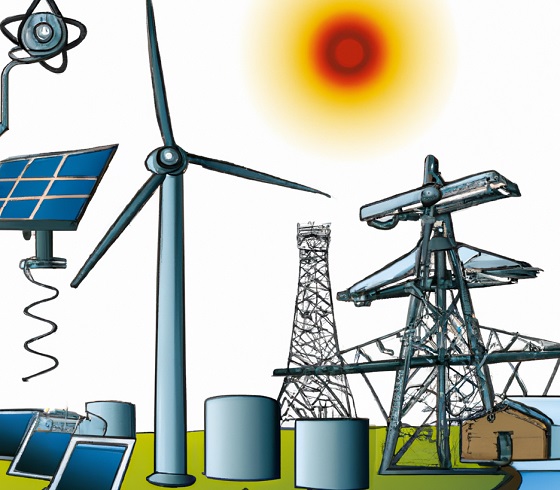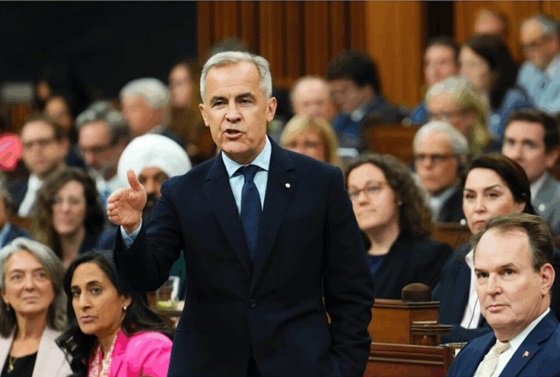Energy
Guilbeault’s Emissions Obsession: Ten Reasons to Call Time Out on Canada’s CO2 Crusade

From the Frontier Centre for Public Policy
Before we collectively devastate our economies, further reduce our birth rates in a misguided attempt to save the planet, squander trillions of dollars, and halt human progress by making energy both scarce and exorbitantly expensive, it’s crucial to remember that human-induced climate change is not a settled fact, but rather a hypothesis largely unsupported by the history of the climate but supported by climate models that have considerable error built into them.
Canadian Environment Minister Steven Guilbeault recently announced a plan requiring the oil and gas industry to cut CO2 emissions by more than one-third from 2019 levels by 2030. This deadline might seem far off, but it also stipulates that at least 20 percent of light-duty vehicle sales must be zero-emission by 2026, a deadline that’s just around the corner. This is all part of Guilbeault’s strategy to achieve the ambitious net-zero emissions target by 2050.
There are at least ten reasons suggesting that this plan is absurd.
- CO2 is Not a Pollutant.
Carbon dioxide is, in fact, a fertilizer crucial for the growth of all vegetation. Higher concentrations of CO2 result in increased crop yields and more productive forests. Healthier forests, in turn, absorb more CO2, providing oxygen in exchange which is essential for the survival of all living organisms including humans.
- CO2 is a Trace Gas
During my extensive career as a university professor, I encountered numerous students eager to support policies that might devastate the livelihoods of thousands of men and women who depend on the oil and gas industry, believing these sacrifices would save the planet. Their near-religious zeal was only matched by their stunning ignorance of basic CO2 facts.
Class surveys I conducted showed that almost one hundred percent of my students were unaware that CO2 is a trace gas, with its atmospheric concentration having varied significantly over centuries and even seasonally. Currently, CO2 represents about 0.04% of the atmospheric gases, or approximately 420 parts per million (ppm). By comparison, nitrogen makes up about 78%, and oxygen around 21%.
The best estimates suggest that human activities contribute roughly 4% of the total annual CO2 emissions (16 ppm). Canada’s share of global emissions is approximately 1.5% (0.24 ppm), essentially a rounding error in the total calculation.
- Why Alberta and Not China?
It is no secret that Guilbeault harbours a special animosity towards Alberta. His energy regulations appear designed to severely impact Alberta’s economy despite the province being a relatively minor player on the global stage. In contrast, China, by far the largest contributor to global CO2 emissions, builds two new coal-powered (dirty) power plants every week and is the primary beneficiary of Canada’s coal exports. Why doesn’t Guilbeault turn his scornful gaze towards the People’s Republic? Even during his visit to China in August 2023 for climate talks, not only did he overlook that country’s appalling environmental track record, to add insult to injury, while there he critiqued Suncor for recommitting to oil sands development, highlighting a troubling policy double standard.
- Watch What They Do, not What They Say
The economic and cultural elites, who incessantly warn of an impending climate catastrophe, seem to contradict their own claims by their extravagant lifestyles. Their opulent residences, frequent use of private jets, and other extravagances reveal a significant disconnect between their rhetoric and their behaviour, suggesting either hypocrisy or a lack of belief in the very crisis they promote.
- Magical Thinking
When they purport to compel the oil and gas industry to adopt new technologies, politicians and policymakers indulge in a particularly delusional form of magical thinking. First, the industry is already one of the most innovative sectors in the economy. Second, these individuals demonstrate a profound ignorance of both climate change and the complex challenges of energy production. As is typical of low-information politicians, they seem to believe that all they need to do to enact change in line with their utopian ideals is to snap their fingers or twitch their collective nose.
- A Multiplier of Human Misery
All the regulations that politicians like Guilbeault introduce with a regularity that rivals the proverbial cuckoo clock have nothing to do with creating new sources of energy or making energy more accessible and affordable. If they were genuinely concerned about their constituents’ welfare, these politicians would incentivize nuclear energy. But they conspicuously do not. These incessant regulations, taxes, and oppressive energy policies serve one purpose: to inflate energy prices so high that middle-class individuals are forced to drive less, reduce their energy use for heating and cooling their homes, and drastically curbing manufacturing. To the extent that such policies persist, they will impose an increasingly devastating economic burden on the poor and the working class.
- Extreme Weather Events
A radical reduction in CO2 emissions will not only lead to a weaker economy and increased poverty, but it will also diminish our capacity to respond to extreme weather conditions, which will occur regardless of the taxation governments impose on human activities.
- The Used-Car Salesman Syndrome
You know you’re being conned when a used car salesperson fails to mention the downsides of the vehicle being considered. The same skepticism and caution should be applied to politicians who tout only the benefits of their proposed policies without discussing the costs. Either they are blissfully unaware of these costs, or they believe they will be insulated from the real-world repercussions of their harmful policies due to their status, wealth, or connections.
- Anti-Human Perspective
While it’s unwise to gratuitously attribute malicious intent to anyone, the evidence suggests that proponents of radical climate change policies operate from what can only be described as an anti-human perspective. They view human beings as liabilities and parasites rather than, as the Judeo-Christian tradition asserts, the valuable assets they truly are.
- A Matter of Debate
Before we collectively devastate our economies, further reduce our birth rates in a misguided attempt to save the planet, squander trillions of dollars, and halt human progress by making energy both scarce and exorbitantly expensive, it’s crucial to remember that human-induced climate change is not a settled fact, but rather a hypothesis largely unsupported by the history of the climate but supported by climate models that have considerable error built into them.
In conclusion, Bjorn Lomborg, the Danish political scientist and founder of the prestigious Copenhagen Consensus Center—an organization renowned for producing some of the most authoritative studies on environmental issues—wisely reminds us that while there are environmental concerns needing attention, it’s questionable whether climate change constitutes an existential crisis that warrants dedicating all our resources at the expense of human life and flourishing.
Pierre Gilbert is Associate Professor Emeritus at Canadian Mennonite University. He writes here for the Frontier Centre for Public Policy.
Energy
Liberals Twisted Themselves Into Pretzels Over Their Own Pipeline MOU

From Energy Now
By Margareta Dovgal
Playing politics with pipelines is a time-honored Canadian tradition. Recent events in the House of Commons offered a delightful twist on the genre.
The Conservatives introduced a motion quoting the Liberals’ own pipeline promises laid out in the Memorandum of Understanding (MOU) with Alberta, nearly verbatim. The Liberals, true to form, killed it 196–139 with enthusiastic help from the NDP, Bloc, and Greens.
We all knew how this would end. Opposition motions like this never pass; no government, especially not one led by Mark Carney, is going to let the opposition dictate the agenda. There’s not much use feigning outrage that the Liberals voted it down. The more entertaining angle has been watching closely as Liberal MPs twist themselves into pretzels explaining why they had to vote “no” on a motion that cheers on a project they claim to support in principle.
Liberal MP Corey Hogan dismissed the motion as “game-playing” designed to “poke at people”.
And he’s absolutely right to call it a “trap” for the Liberals. But traps only work when you walk into them.
Indigenous Services Minister Mandy Gull-Masty deemed the motion an “immature waste of parliamentary time” and “clearly an insult towards Indigenous Peoples” because it didn’t include every clause of the original agreement. Energy Minister Tim Hodgson decried it as a “cynical ploy to divide us” that “cherry-picked” the MOU.
Yet the prize for the most tortured metaphor goes to the prime minister himself. Defending his vote against his own pipeline promise, Carney lectured the House that “you have to eat the entire meal, not just the appetizer.”
It’s a clever line, and it also reveals the problem. The “meal” Carney is serving is stuffed with conditions. Environmental targets or meaningful engagement with Indigenous communities aren’t unrealistic asks. A crippling industrial carbon price as a precondition might be though.
But the prime minister has already said the quiet part out loud.
Speaking in the House a few weeks ago, Carney admitted that the agreement creates “necessary conditions, but not sufficient conditions,” before explicitly stating: “We believe the government of British Columbia has to agree.”
There is the poison pill. Handing a de facto veto to a provincial government that has spent years fighting oil infrastructure is neither constitutionally required nor politically likely. Elevating B.C.’s “agreement” to a condition, which is something the MOU text itself carefully avoids doing, means that Carney has made his own “meal” effectively inedible.
Hodgson’s repeated emphasis that the Liberal caucus supports “the entire MOU, the entire MOU” only reinforces this theory.
This entire episode forces us to ask whether the MOU is a real plan to build a pipeline, or just a national unity play designed to cool down the separatist temperature in Alberta. My sense is that Ottawa knew they had to throw a bone to Premier Danielle Smith because the threat of the sovereignty movement is gaining real traction. But you can’t just create the pretense of negotiation to buy time.
With the MOU getting Smith boo’ed at her own party’s convention by the separatists, it’s debatable whether that bone was even an effective one to throw.
There is a way. The federal government has the jurisdiction. If they really wanted to, they could just do it, provided the duty to consult with and accommodate Indigenous peoples was satisfied. Keep in mind: no reasonable interpretation equates Section 35 of the Charter to a veto.
Instead, the MOU is baked with so many conditions that the Liberals have effectively laid the groundwork for how they’re going to fail.
With overly-hedged, rather cryptic messaging, Liberals have themselves given considerable weight to a cynical theory, that the MOU is a stalling tactic, not a foundation to get more Canadian oil to the markets it’s needed in. Maybe Hodgson is telling the truth, and caucus is unified because the radicals are satisfied that “the entire MOU” ensures that a new oil pipeline will never reach tidewater through BC.
So, hats off to the legislative affairs strategists in the Conservative caucus. The real test of Carney’s political power continues: can he force a caucus that prefers fantasy economics into a mold of economic literacy to deliver on the vision Canadians signed off on? Or will he be hamstrung trying to appease the radicals from within?
Margareta Dovgal is managing director of Resource Works Society.
Daily Caller
Paris Climate Deal Now Decade-Old Disaster


From the Daily Caller News Foundation
By Steve Milloy
The Paris Climate Accord was adopted 10 years ago this week. It’s been a decade of disaster that President Donald Trump is rightly trying again to end.
The stated purpose of the agreement was for countries to voluntarily cut emissions to avoid the average global temperature exceeding the (guessed at) pre-industrial temperature by 3.6°F (2°C) and preferably 2.7°F (1.5°C).
Since December 2015, the world spent an estimated $10 trillion trying to achieve the Paris goals. What has been accomplished? Instead of reducing global emissions, they have increased about 12 percent. While the increase in emissions is actually a good thing for the environment and humanity, spending $10 trillion in a failed effort to cut emissions just underscores the agreement’s waste, fraud and abuse.
As a nonprofit, we are dependent on the generosity of our readers.
Please consider making a small donation of any amount here.
Thank you!
But wasting $10 trillion is only the tip of the iceberg.
The effort to cut emissions was largely based on forcing industrial countries to replace their tried-and-true fossil fuel-based energy systems with not-ready-for-prime-time wind, solar and battery-based systems. This forced transition has driven up energy costs and made energy systems less reliable. The result of that has been economy-crippling deindustrialization in former powerhouses of Germany and Britain.
And it gets worse.
European nations imagined they could reduce their carbon footprint by outsourcing their coal and natural gas needs to Russia. That outsourcing enriched Russia and made the European economy dependent on Russia for energy. That vulnerability, in turn, and a weak President Joe Biden encouraged Vladimir Putin to invade Ukraine.
The result of that has been more than one million killed and wounded, the mass destruction of Ukraine worth more than $500 billion so far and the inestimable cost of global destabilization. Europe will have to spend hundreds of billions more on defense, and U.S. taxpayers have been forced to spend hundreds of billions on arms for Ukraine. Putin has even raised the specter of using nuclear weapons.
President Barack Obama unconstitutionally tried to impose the Paris agreement on the U.S. as an Executive agreement rather than a treaty ratified by the U.S. Senate. Although Trump terminated the Executive agreement during his first administration, President Joe Biden rejoined the agreement soon after taking office, pledging to double Obama’s emissions cuts pledge to 50 percent below 2005 levels by 2030.
Biden’s emissions pledge was an impetus for the 2022 Inflation Reduction Act that allocated $1.2 trillion in spending for what Trump labeled as the Green New Scam. Although Trump’s One Big Beautiful Bill Act reduced that spending by about $500 billion and he is trying to reduce it further through Executive action, much of that money was used in an effort to buy the 2024 election for Democrats. The rest has been and will be used to wreck our electricity grid with dangerous, national security-compromising wind, solar and battery equipment from Communists China.
Then there’s this. At the Paris climate conference in 2015, U.S. Secretary of State John Kerry stated quite clearly that emissions cuts by the U.S. and other industrial countries were meaningless and would accomplish nothing since the developing world’s emissions would be increasing.
Finally, there is the climate realism aspect to all this. After the Paris agreement was signed and despite the increase in emissions, the average global temperature declined during the years from 2016 to 2022, per NOAA data.
The super El Nino experienced during 2023-2024 caused a temporary temperature spike. La Nina conditions have now returned the average global temperature to below the 2015-2016 level, per NASA satellite data. The overarching point is that any “global warming” that occurred over the past 40 years is actually associated with the natural El Nino-La Nina cycle, not emissions.
The Paris agreement has been all pain and no gain. Moreover, there was never any need for the agreement in the first place. A big thanks to President Trump for pulling us out again.
Steve Milloy is a biostatistician and lawyer. He posts on X at @JunkScience.
-

 Energy2 days ago
Energy2 days agoCanada’s sudden rediscovery of energy ambition has been greeted with a familiar charge: hypocrisy
-

 Censorship Industrial Complex2 days ago
Censorship Industrial Complex2 days agoDeath by a thousand clicks – government censorship of Canada’s internet
-

 Digital ID2 days ago
Digital ID2 days agoCanada releases new digital ID app for personal documents despite privacy concerns
-

 Energy2 days ago
Energy2 days agoCan we not be hysterical about AI and energy usage?
-

 Business4 hours ago
Business4 hours agoOttawa Pretends To Pivot But Keeps Spending Like Trudeau
-

 armed forces22 hours ago
armed forces22 hours agoOttawa’s Newly Released Defence Plan Crosses a Dangerous Line
-

 International2 days ago
International2 days agoRussia Now Open To Ukraine Joining EU, Officials Briefed On Peace Deal Say
-

 Censorship Industrial Complex1 hour ago
Censorship Industrial Complex1 hour agoHow Wikipedia Got Captured: Leftist Editors & Foreign Influence On Internet’s Biggest Source of Info









